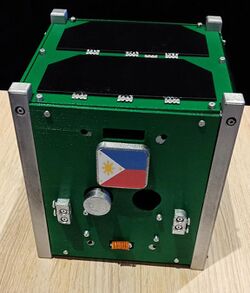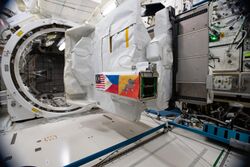Engineering:Birds-2
Birds-2 is the second iteration of a multinational program called the Joint Global Multi-Nations Birds Satellite project, or Birds project, to help countries build their first satellite. The Japanese Kyushu Institute of Technology (KIT) supported the design and fabrication of the satellites. The satellites were launched by the Falcon 9 Full Thrust rocket as a part of the SpaceX CRS-15 mission on 29 June 2018. The satellites were released from the Kibō module of the International Space Station (ISS) in August 2018.
Background
The Kyushu Institute of Technology (KIT) in Japan supports non-spacefaring countries to build their first satellite through a program called the Joint Global Multi-Nations Birds Satellite project (Birds). Five countries had their satellites successfully launched in the Birds-1 flight: Japan , Ghana, Mongolia, Nigeria, and Bangladesh.[1]
Three countries participated in the Birds-2 program: Bhutan, the Philippines , and Malaysia.[2] UiTMSAT-1 was Malaysia's first university-built satellite.[3] Bhutan's satellite, BHUTAN-1, was the country's first satellite.[4] The Philippines built their first cubesat, Maya-1.[5]
Development and design

All three satellites were built the same. The satellites were designed to last 6–9 months.[6]
Mission
Launch
The constellation was launched in SpaceX's Dragon spacecraft, lofted into space with their Falcon 9 rocket. It was the 15th launch of the Cargo Resupply Mission (CRS) contract to the International Space Station (ISS).[5] Dragon was captured by Canadarm2 and docked with the space station on 2 July 2018.[7] The satellites were released from the Kibō module of the International Space Station in August 2018.[8]
Operations
The satellites have camera systems for imaging the Earth. Amateur radio operators can receive data transmitted from the satellites. Each country's receiving station can receive data from all three satellites with a store and forward (S&F) system.[9]
References
- ↑ "Bird B, BTN, G, J, M, MYS, N, PHL (BRAC Onnesha, GhanaSat-1, Toki, Mazaalai, Nigeria EduSat-1)". Gunter's Space Page. Archived from the original. Error: If you specify
|archiveurl=, you must also specify|archivedate=. https://web.archive.org/web/20170630201409/http://space.skyrocket.de/doc_sdat/bird.htm. - ↑ "Birds-2 CubeSats to deploy from ISS August 10". AMSAT-UK. August 3, 2018. https://amsat-uk.org/2018/08/03/birds-2-cubesats-iss-august-10/.
- ↑ Alam, Shah (June 30, 2018). "Uitm Reaches Milestone In Space". www.BruDirect.com. http://brudirect.com/news.php?id=49673.
- ↑ "CubeSats for Birds-2 handed over to JAXA. Launch preparations completed!". JAXA. June 26, 2018. http://iss.jaxa.jp/en/kiboexp/news/180626_birds-2.html.
- ↑ 5.0 5.1 Goh, Deyana (June 29, 2018). "Cubesats from Malaysia, Bhutan and the Philippines on SpaceX's Dragon launch". SpaceTech Asia. http://www.spacetechasia.com/cubesats-from-malaysia-bhutan-the-philippines-on-spacexs-dragon-launch/.
- ↑ "Press Release: Launch of Bhutan's First Satellite BHUTAN-1". Bhutan Ministry of Information and Communications. June 29, 2018. http://www.moic.gov.bt/en/press-releaselaunch-of-bhutans-first-satellite-bhutan-1/.
- ↑ Clark, Stephen (July 2, 2018). "Dragon capsule reaches space station with three tons of cargo". Spaceflight Now. https://spaceflightnow.com/2018/07/02/dragon-capsule-reaches-space-station-with-three-tons-of-cargo/.
- ↑ "Three CubeSats successfully deployed from "Kibō" as part of Birds project!". JAXA. August 17, 2018. http://iss.jaxa.jp/en/kiboexp/jssod/1808_en_cubesats9.html.
- ↑ Ronda, Rainier Allan (March 1, 2018). "Pinoy-built cubesat ready for launch in June". philstar Global. https://www.philstar.com/business/science-and-environment/2018/03/01/1792231/pinoy-built-cubesat-ready-launch-june.
 |




